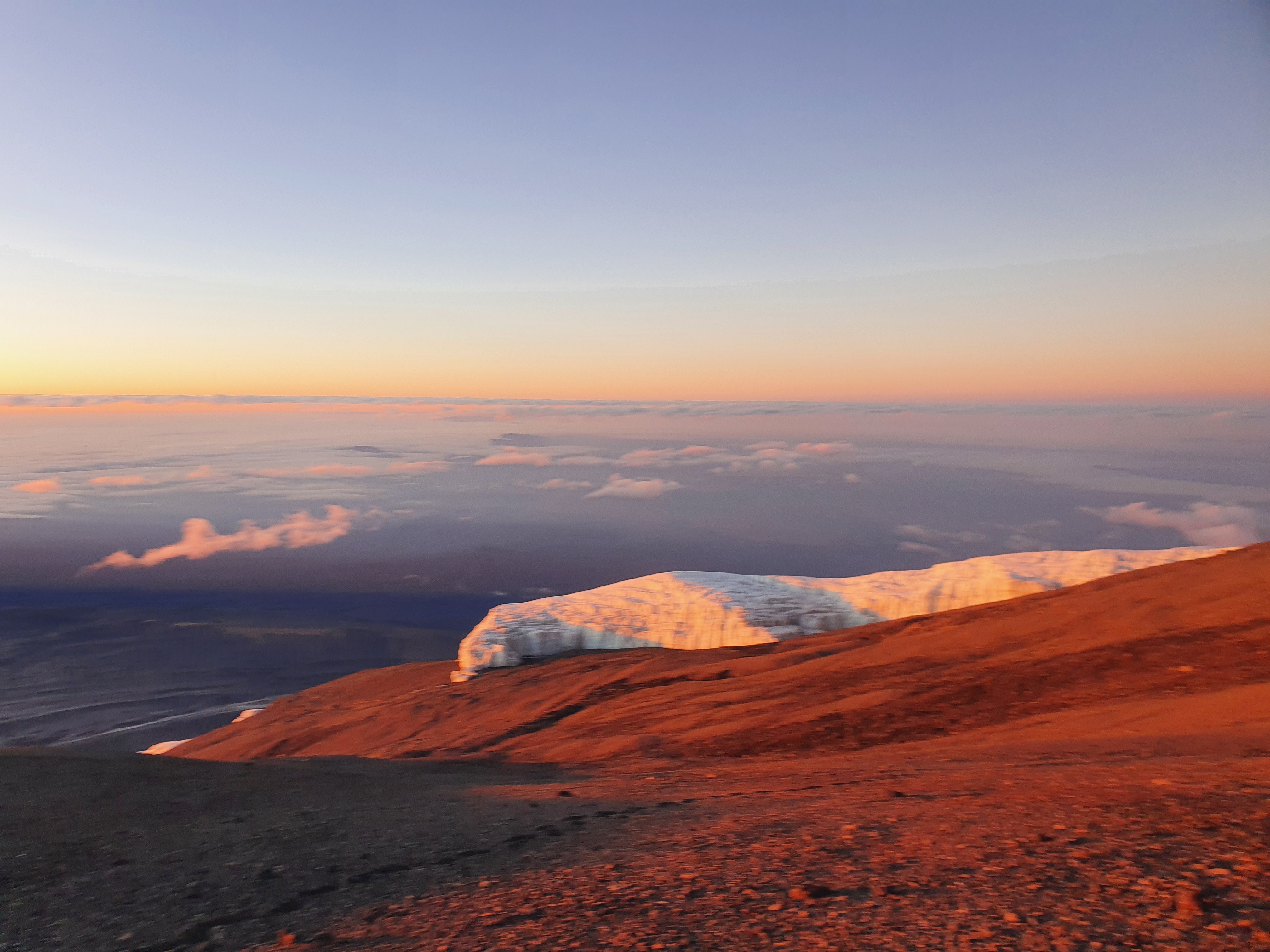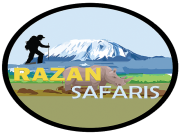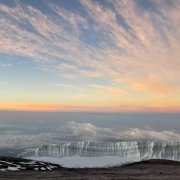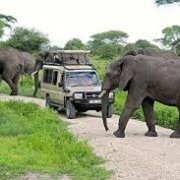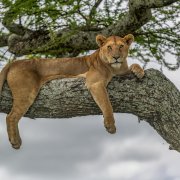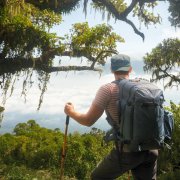Top Tour Operators and Travel Agency in Tanzania. Best Tanzania wildlife safaris experience, Best Tanzania safari Tour, Affordable Tanzania Safari, Tanzania Big 5 Safari, Wlidebeest Migration safari, Photography Safari in Tanzania, Cultural safari experience, Walking safari in Tanzania, Hoit Air Balloon safari, Mount Kilimanjaro packages, Zanzibar beach relaxation, Luxury Safari Lodge in Tanzania, budget Camping safari and Affordable Safari Accommodation.
RAZAN SAFARIS
https://www.startus.cc/company/razan-safaris
Moshi, Tanzania
Boma Rd
25101 Moshi
Tanzania General information:
Company information:
Company type:
Company
Industry:
Travel / Tourism
Founded when:
Friday, 23 March, 2018
Startup stage:
Shipping stage (actively selling)
Funding needs:
Series A funding
Types of jobs in the company:
Business Development, Sales, Other Occupations
Total numbers of employees:
32
Products and Services:
6 days Kilimanjaro Climbing Machame route
Product category:
Kilimanjaro Climbing Machame Route
Embark on an exhilarating 6-day trek along the legendary Machame Route, a scenic and challenging path to the summit of Africa's highest peak, Mount Kilimanjaro. This iconic route winds its way through diverse landscapes, from lush rainforests teeming with exotic flora and fauna to rugged alpine terrain and vast expanses of rocky slopes. As you ascend, you'll be mesmerized by breathtaking vistas of the surrounding valleys and distant peaks, while acclimatizing to the increasing altitude under the guidance of experienced mountain guides. Each day brings new challenges and triumphs, culminating in an awe-inspiring sunrise summit bid from Stella Point to Uhuru Peak, where you'll stand atop the Roof of Africa at 5,895 meters (19,341 feet). With each step, you'll not only conquer the physical demands of the trek but also forge lasting memories and bonds with fellow adventurers, making this 6-day Machame Route expedition an unforgettable journey of a lifetime.
Day 1: Hotel to Machame Camp
Drive from Moshi to Machame Gate takes about 45 minutes. The journey passes through the village of Machame which is located on the lower slopes of the mountain.
We depart the park gate and walk through the rain forest on a winding trail up a ridge. At lower elevations the trail can be muddy and slippery. Gaiters and trekking poles are a good idea here. We continue a short distance until we reach the Machame Camp.
Elevation: 1830m/6000ft to 3050m/9950ft
Distance: 11km/7mi
Hiking Time: 5-6 hours
Habitat: Montane Forest
Meals: Lunch and Dinner
Day 2: Machame Camp to Shira Camp
After breakfast we leave the glades of the rain forest and continue on an ascending path, crossing the valley along a steep rocky ridge. The route now turns west onto a river gorge until we arrive at the Shira campsite.
Elevation: 3050m/9950ft to 3850m/12,600ft
Distance: 5km/3mi
Walking Time: 4-5 hours
Habitat: Moorland
Meals: Breakfast, Lunch and Dinner
Day 3: Shira Camp to Lava Tower to Barranco Camp
From the Shira Plateau we continue to the east up a ridge, passing the junction towards the peak of Kibo. As we continue, our direction changes to the South East towards the Lava Tower, called the “Shark’s Tooth” (elev 4650m/15,250ft). Shortly after the tower we come to the second junction which goes to the Arrow Glacier. We now continue down to the Barranco Camp. Although you end the day around the same elevation as when you began, this day is very important for acclimatization and will help your body prepare for summit day.
Elevation: 3850m/12,600ft to 4000m/13,000ft
Distance: 10km/6mi
Walking Time: 5-6 hours
Habitat: Semi-desert
Meals: Breakfast, Lunch and Dinner
Day 4: Barranco Camp to Barafu Camp
After breakfast, we leave Barranco and continue on a steep ridge up the Barranco Wall (elev 4250m/13,900ft), through the Karanga Valley (elev 4050m/13,250ft) to the junction which connects with the Mweka Trail. We continue up to the Barafu Camp. You have completed the South Circuit, which offers views of the summit from many different angles. Here we make camp with views of the summit in the distance.
Elevation: 4000m/13,000ft to 4700m/15,350ft
Distance: 9km/6mi
Hiking Time: 6-8 hours
Habitat: Alpine Desert
Meals: Breakfast, Lunch and Dinner
Day 5: Barafu Camp to Summit to Mweka Camp
Very early in the morning (midnight to 2 am), we continue our way to the summit between the Rebmann and Ratzel glaciers. You head in a northwesterly direction and ascend through heavy scree towards Stella Point on the crater rim. This is the most mentally and physically challenging portion of the trek. At Stella Point you will stop for a short rest and will be rewarded with the most magnificent sunrise you are ever likely to see. Faster hikers may view the sunrise from the summit.
From Stella Point, you may encounter snow all the way on your 1-hour ascent to the summit. Once at Uhuru Peak you have reached the highest point on Mount Kilimanjaro and the continent of Africa!
From the summit we begin our descent by continuing straight down to the Mweka Camp, stopping at Barafu for lunch. You may want gaiters and trekking poles for the loose gravel going down. We arrive at Mweka Camp and enjoy our last evening on the mountain.
Elevation: 4700m/15,350ft to 5895m/19,340ft
Down to 3090m/10,150ft
Distance: 5km/3mi up / 13km/8mi down
Hiking Time: 5-7 hours up / 5-6 hours down
Habitat: Stone scree and ice-capped summit
Meals: Breakfast, Lunch and Dinner
Day 6: Mweka Camp to Mweka Gate to Hotel
After breakfast we continue the descent down to the Mweka Park Gate to receive your summit certificates. At lower elevations, it can be wet and muddy. Gaiters and trekking poles will help. Shorts and t-shirts will probably be plenty to wear (keep rain gear and warmer clothing handy).
Our vehicle will be waiting for you at Mweka gate to drive you back to your hotel in Moshi (around 60 minutes).
Elevation: 3090m/10,150ft to 1680m/5500ft
Distance: 10km/6mi
Hiking Time: 3-4 hours
Habitat: Forest
Meals: Breakfast

Machame route 7 days on Kilimanjaro
Product category:
Kilimanjaro Climbing Machame Route
Embarking on a 7-day Kilimanjaro climb via the Machame route allows for a well-paced ascent, ample acclimatization time, and an increased chance of summit success. This 7-day Machame route itinerary offers a comprehensive and unforgettable Kilimanjaro climb via the Machame route, providing ample time for acclimatization, breathtaking scenery, and a successful summit bid.
Day 0: Pre-trek Briefing
If you have opted for the optional airport transfers, we will pick you up from Kilimanjaro Airport or Arusha airport and transfer you to your hotel in Moshi.
Pre-trek briefing at your Moshi hotel. You should be planning to arrive atleast one day before the start of the trek. Today we will spend in having a pre-trek briefing. We will also review your equipment and rent any equipment which is needed.
Day 1: Hotel to Machame Camp
Drive from Moshi to Machame Gate takes about 45 minutes. The journey passes through the village of Machame which is located on the lower slopes of the mountain.
We depart the park gate and walk through the rain forest on a winding trail up a ridge. At lower elevations the trail can be muddy and slippery. Gaiters and trekking poles are a good idea here. We continue a short distance until we reach the Machame Camp.
Elevation: 1830m/6000ft to 3050m/9950ft
Distance: 11km/7mi
Hiking Time: 5-6 hours
Habitat: Montane Forest
Meals: Lunch and Dinner
Day 2: Machame Camp to Shira Camp
After breakfast we leave the glades of the rain forest and continue on an ascending path, crossing the valley along a steep rocky ridge. The route now turns west onto a river gorge until we arrive at the Shira campsite.
Elevation: 3050m/9950ft to 3850m/12,600ft
Distance: 5km/3mi
Walking Time: 4-5 hours
Habitat: Moorland
Meals: Breakfast, Lunch and Dinner
Day 3: Shira Camp to Lava Tower to Barranco Camp
From the Shira Plateau we continue to the east up a ridge, passing the junction towards the peak of Kibo. As we continue, our direction changes to the South East towards the Lava Tower, called the “Shark’s Tooth” (elev 4650m/15,250ft). Shortly after the tower we come to the second junction which goes to the Arrow Glacier. We now continue down to the Barranco Camp. Although you end the day around the same elevation as when you began, this day is very important for acclimatization and will help your body prepare for summit day.
Elevation: 3850m/12,600ft to 4000m/13,000ft
Distance: 10km/6mi
Walking Time: 5-6 hours
Habitat: Semi-desert
Meals: Breakfast, Lunch and Dinner
Day 4: Barranco Camp to Karanga Camp
After breakfast, we leave Barranco and continue on a steep ridge up the Barranco Wall to the Karanga Valley and the junction which connects with the Mweka Trail.
Elevation: 4000m/13,000ft to 4050m/13,250ft
Distance: 5km/3mi
Climbing Time: 3-4 hours
Habitat: Alpine Desert
Meals: Breakfast, Lunch and Dinner
Day 5: Karanga Camp to Barafu Camp
We continue up to the Barafu Camp. You have completed the South Circuit, which offers views of the summit from many different angles. Here we make camp, rest, enjoy dinner, and prepare for the summit day.
Elevation: 4050m/13,250ft to 4700m/15,350ft
Distance: 4km/2mi
Climbing Time: 3-4 hours
Habitat: Alpine Desert
Meals: Breakfast, Lunch and Dinner
Day 6: Barafu Camp to Summit to Mweka Camp
Very early in the morning (midnight to 2 am), we continue our way to the summit between the Rebmann and Ratzel glaciers. You head in a northwesterly direction and ascend through heavy scree towards Stella Point on the crater rim. This is the most mentally and physically challenging portion of the trek. At Stella Point you will stop for a short rest and will be rewarded with the most magnificent sunrise you are ever likely to see. Faster hikers may view the sunrise from the summit.
From Stella Point, you may encounter snow all the way on your 1-hour ascent to the summit. Once at Uhuru Peak you have reached the highest point on Mount Kilimanjaro and the continent of Africa!
From the summit we begin our descent by continuing straight down to the Mweka Camp, stopping at Barafu for lunch. You may want gaiters and trekking poles for the loose gravel going down. We arrive at Mweka Camp and enjoy our last evening on the mountain.
Elevation: 4700m/15,350ft to 5895m/19,340ft
Down to 3090m/10,150ft
Distance: 5km/3mi up / 13km/8mi down
Hiking Time: 5-7 hours up / 5-6 hours down
Habitat: Stone scree and ice-capped summit
Meals: Breakfast, Lunch and Dinner
Day 7: Mweka Camp to Mweka Gate to Hotel
After breakfast we continue the descent down to the Mweka Park Gate to receive your summit certificates. At lower elevations, it can be wet and muddy. Gaiters and trekking poles will help. Shorts and t-shirts will probably be plenty to wear (keep rain gear and warmer clothing handy).
Razan Safaris vehicle will be waiting for you at Mweka gate to drive you back to your hotel in Moshi (around 60 minutes).
Elevation: 3090m/10,150ft to 1680m/5500ft
Distance: 10km/6mi
Hiking Time: 3-4 hours
Habitat: Forest
Meals: Breakfast
The price for 7 days Machame route is USD ($) 1750 Per Climber
Inclusions
All transfers to the mountain and back to your Moshi hotel
Professional, experienced, mountain guides
Guides, Porters, Cook salaries and park fees
Quality, waterproof, four-season mountain sleeping tents (on twin sharing basis)
Sleeping Mattress
Emergency Oxygen Cylinder
All meals while on the Mountain
Quality Mess tents with table and chairs
Large portions of fresh, healthy, nutritious food
Clean, purified drinking water
Conservation fees (part of park fees)
Camping or Hut fees (part of park fees)
Rescue fees (part of park fees)
VAT (18% charged by the Government)
Kilimanjaro summit certificate
Exclusions
Tanzania Visa
International and domestic flights
Hotel (available as an optional addon)
Transfers (available as an optional addon)
Personal trekking equipment such as sleepings bags, hiking boots, clothes, etc (available for renting)
Tips and gratuities
Travel insurance
Personal Expenses (e.g. laundry, telephone, beverages, etc.)
Meals not listed in the itinerary
Liquors, beers and bottled beverages
Surcharge for online payment of advance and balance (5% on each payment)

8 days Kilimanjaro Climbing Via Lemosho route
Product category:
8 DAYS KILIMANJARO CLIMBING VIA LEMOSHO ROUTE
Embarking on an 8-day Kilimanjaro climb via the Lemosho route offers a well-paced ascent, ample acclimatization time, and stunning scenery.
This 8-day Kilimanjaro Climbing via Lemosho route itinerary offers a comprehensive and unforgettable Kilimanjaro climb via the Lemosho route, providing ample time for acclimatization, breathtaking scenery, and a successful summit bid.
Day 0: Arrival in Moshi
Arrive in Moshi, Tanzania, the starting point for your Kilimanjaro adventure.
Meet your guide and fellow climbers for a pre-trek briefing.
Spend the day resting, preparing gear, and acclimatizing to the altitude.
Day 1: Moshi to Londorossi Gate to Mti Mkubwa Camp (Hike)
Morning: Transfer to Londorossi Gate (2,250 meters) to begin your trek.
Complete registration formalities before starting the hike.
Trek through lush rainforest, with opportunities to spot wildlife.
Lunch: Enjoy a picnic lunch along the trail.
Afternoon: Arrive at Mti Mkubwa Camp (2,820 meters) for dinner and overnight stay.
Day 2: Mti Mkubwa Camp to Shira 1 Camp (Hike)
Morning: Continue ascending through the rainforest, gradually leaving the treeline behind.
Lunch: Picnic lunch at a scenic spot with panoramic views of Kilimanjaro.
Afternoon: Trek through the heath and moorland zone to Shira 1 Camp (3,505 meters) for dinner and overnight stay.
Day 3: Shira 1 Camp to Shira 2 Camp (Hike)
Morning: Trek across the Shira Plateau, taking in breathtaking views of the surrounding landscape.
Lunch: Enjoy a packed lunch along the trail.
Afternoon: Ascend to Shira 2 Camp (3,840 meters), where you'll spend the night.
Day 4: Shira 2 Camp to Barranco Camp (Hike)
Morning: Continue ascending towards Lava Tower (4,630 meters) for acclimatization.
Lunch: Picnic lunch at Lava Tower before descending to Barranco Camp.
Afternoon: Descend to Barranco Camp (3,950 meters), where you'll spend the night.
Day 5: Barranco Camp to Karanga Camp (Hike)
Morning: Tackle the Barranco Wall, a thrilling climb offering panoramic views.
Lunch: Picnic lunch along the trail as you traverse the Karanga Valley.
Afternoon: Arrive at Karanga Camp (3,995 meters) for dinner and overnight stay.
Day 6: Karanga Camp to Barafu Camp (Hike)
Morning: Ascend to Barafu Camp (4,673 meters), the final base camp before the summit.
Lunch: Enjoy a hearty meal at Barafu Camp to fuel your summit attempt.
Afternoon: Rest, hydrate, and prepare for the summit bid.
Evening: Early dinner and early bedtime to rest before the summit push.
Day 7: Summit Day - Barafu Camp to Uhuru Peak to Mweka Camp (Hike)
Midnight: Begin the summit attempt, ascending under the starlit sky.
Early Morning: Reach Stella Point (5,756 meters) and continue to Uhuru Peak (5,895 meters) for sunrise.
Sunrise: Witness the breathtaking sunrise over the East African plains from the summit.
Morning: Descend back to Barafu Camp for a short rest before continuing to Mweka Camp (3,100 meters).
Afternoon: Descend through the alpine desert and rainforest to Mweka Camp for a celebratory dinner and overnight stay.
Day 8: Mweka Camp to Mweka Gate (Descent) and Departure
Morning: Descend through the lush rainforest to Mweka Gate (1,650 meters).
Lunch: Enjoy a farewell lunch at Mweka Gate and receive summit certificates.
Afternoon: Transfer back to Moshi for a well-deserved rest and celebratory dinner.
Departure the following day.
Razan Safaris Price for 8 days Kilimanjaro Climbing Lemosho route is From USD ($) 1800 per Climber.
Price includes:
Trekking tour according to the itinerary
Accommodation in tents and hotels as indicated in the itinerary
Professional English-speaking guide
Personal porter
Meals as indicated in the itinerary
Drinking water
Transfers as indicated in the itinerary
Camping equipment – tents, sleeping mattress and camping furniture
Portable toilet and toilet tent
National park fees
Rescue fees
Price excludes:
Flights (international and domestic)
Meals not indicated in the itinerary
Beverages other than water (alcohol and soft drinks)
Visa, tips, personal expenses, travel insurance
Sleeping bag (can be rented, please ask us at the time of the booking)

Lemosho route 7 days
Product category:
Kilimanjaro Climbing Lemosho Route
There are six established routes to climb Mount Kilimanjaro – Marangu, Machame, Lemosho, Shira, Rongai and Umbwe. The Marangu, Machame, and Umbwe routes all approach from the south of the mountain. The Lemosho and Shira routes approach from the west. The Rongai route approaches from the north near Kenya. All routes except Marangu descend via Mweka.
Lemosho Route on Mount Kilimanjaro
Climbing Mount Kilimanjaro via The 7 days Lemosho Route
As a newer route, it is more remote and arguably more beautiful, but a bit longer and slightly more expensive. It starts on the Western side of the mountain at the Londorossi Gate which is a further drive from town, and was introduced as an alternative to the Shira route.
After beautiful forests and moorlands it crosses the Shira Plateau on day 3 to connect with the Machame Route at Lava Tower and down towards Barranco Valley via the Southern Circuit. You may be lucky enough to see buffalo, elephant and other game. Because this route can be done over a longer period of time for acclimatization, it has a higher success rate of summit.
Day 0: Pre-trek Briefing
If you have opted for the optional airport transfers, we will pick you up from Kilimanjaro Airport or Arusha airport and transfer you to your hotel in Moshi.
Pre-trek briefing at your Moshi hotel. You should be planning to arrive atleast one day before the start of the trek. Today we will spend in having a pre-trek briefing. We will also review your equipment and rent any equipment which is needed.
Day 1: Hotel to Mti Mkubwa Camp
After breakfast and briefing, drive to Lemosho Park Gate. From here a forest track requiring a 4WD vehicle leads to Lemosho Glades. Walk along forest trails to Mti Mkubwa (big tree) campsite.
Elevation: 1830m/6000ft to 2650m/8700ft
Distance: 6km/4mi
Hiking Time: 2-3 hours
Habitat: Montane Forest
Meals: Lunch and Dinner
Day 2: Mti Mkubwa Camp to Shira 2 Camp
After breakfast, we continue as the trail gradually steepens and enters the giant heather moorland zone. After several streams are crossed we continue over the Shira Ridge past the Shira 1 camp and on to the Shira 2 camp on moorland meadows by a stream.
Elevation: 2650m/8700ft to 3850m/12,600ft
Distance: 16km/10mi
Hiking Time: 7-8 hours
Habitat: Moorland
Meals: Breakfast, Lunch and Dinner
Day 3: Shira 2 Camp to Barranco Camp
From the Shira Plateau we continue to the east up a ridge, passing the junction towards the peak of Kibo. As we continue, our direction changes to the South East towards the Lava Tower, called the “Shark’s Tooth” (elev 4650m/15,250ft). Shortly after the tower we come to the second junction which goes to the Arrow Glacier. We now continue down to the Barranco Camp. Although you end the day around the same elevation as when you began, this day is very important for acclimatization and will help your body prepare for summit day.
Elevation: 3850m/12,600ft to 4000m/13,000ft
Distance: 8km/5mi
Walking Time: 5-6 hours
Habitat: Semi-desert
Meals: Breakfast, Lunch and Dinner
Day 4: Barranco Camp to Karanga Camp
After breakfast, we leave Barranco and continue on a steep ridge up the Barranco Wall to the Karanga Valley and the junction which connects with the Mweka Trail.
Elevation: 4000m/13,000ft to 4050m/13,250ft
Distance: 5km/3mi
Climbing Time: 3-4 hours
Habitat: Alpine Desert
Meals: Breakfast, Lunch and Dinner
Day 5: Karanga Camp to Barafu Camp
We continue up to the Barafu Camp. You have completed the South Circuit, which offers views of the summit from many different angles. Here we make camp, rest, enjoy dinner, and prepare for the summit day.
Elevation: 4050m/13,250ft to 4700m/15,350ft
Distance: 4km/2mi
Climbing Time: 3-4 hours
Habitat: Alpine Desert
Meals: Breakfast, Lunch and Dinner
Day 6: Barafu Camp to Summit to Mweka Camp
Very early in the morning (midnight to 2 am), we continue our way to the summit between the Rebmann and Ratzel glaciers. You head in a northwesterly direction and ascend through heavy scree towards Stella Point on the crater rim. This is the most mentally and physically challenging portion of the trek. At Stella Point you will stop for a short rest and will be rewarded with the most magnificent sunrise you are ever likely to see. Faster hikers may view the sunrise from the summit.
From Stella Point, you may encounter snow all the way on your 1-hour ascent to the summit. Once at Uhuru Peak you have reached the highest point on Mount Kilimanjaro and the continent of Africa!
From the summit we begin our descent by continuing straight down to the Mweka Camp, stopping at Barafu for lunch. You may want gaiters and trekking poles for the loose gravel going down. We arrive at Mweka Camp and enjoy our last evening on the mountain.
Elevation: 4700m/15,350ft to 5895m/19,340ft
Down to 3090m/10,150ft
Distance: 5km/3mi up / 13km/8mi down
Hiking Time: 5-7 hours up / 5-6 hours down
Habitat: Stone scree and ice-capped summit
Meals: Breakfast, Lunch and Dinner
Day 7: Mweka Camp to Mweka Gate to Hotel
After breakfast we continue the descent down to the Mweka Park Gate to receive your summit certificates. At lower elevations, it can be wet and muddy. Gaiters and trekking poles will help. Shorts and t-shirts will probably be plenty to wear (keep rain gear and warmer clothing handy).
Razan Safaris vehicle will be waiting for you at Mweka gate to drive you back to your hotel in Moshi (around 60 minutes).
Elevation: 3090m/10,150ft to 1680m/5500ft
Distance: 10km/6mi
Hiking Time: 3-4 hours
Habitat: Forest
Meals: Breakfast
Inclusions
All transfers to the mountain and back to your Moshi hotel
Professional, experienced, mountain guides
Guides, Porters, Cook salaries and park fees
Quality, waterproof, four-season mountain sleeping tents (on twin sharing basis)
Sleeping Mattress
Emergency Oxygen Cylinder
All meals while on the Mountain
Quality Mess tents with table and chairs
Large portions of fresh, healthy, nutritious food
Clean, purified drinking water
Conservation fees (part of park fees)
Camping or Hut fees (part of park fees)
Rescue fees (part of park fees)
VAT (18% charged by the Government)
Kilimanjaro summit certificate
Exclusions
Tanzania Visa
International and domestic flights
Hotel (available as an optional addon)
Transfers (available as an optional addon)
Personal trekking equipment such as sleepings bags, hiking boots, clothes, etc (available for renting)
Tips and gratuities
Travel insurance
Personal Expenses (e.g. laundry, telephone, beverages, etc.)
Meals not listed in the itinerary
Liquors, beers and bottled beverages
Surcharge for online payment of advance and balance (5% on each payment)

Lemosho route 6 days
Product category:
Kilimanjaro Climbing Lemosho Route
The Kilimanjaro Lemosho route is considered the most scenic trail on Kilimanjaro, granting panoramic vistas on various sides of the mountain. As one of the newer routes, Lemosho is a superb choice for your climb. It is our preferred route due to its ideal balance of low crowds, beautiful scenery and a high summit success rate.. Most of clients climb Kilimanjaro using Lemosho route and their feedback to this route is excellent. We highly recommend Lemosho route to our clients. The climb begins at Londorossi Gate at an altitude of 2360 metres, with an approach far to the west of the mountain. It then circles around Kilimanjaro to the south, passing through majestic rainforest where some of the region’s most unique wildlife can often be seen. The route continues up to the mountain’s third summit at Shira Ridge.
Day 0: Pre-trek Briefing
If you have opted for the optional airport transfers, we will pick you up from Kilimanjaro Airport or Arusha Airport and transfer you to your hotel in Moshi.
Pre-trek briefing at your Moshi hotel. You should be planning to arrive at least one day before the start of the trek. Today we will spend in having a pre-trek briefing. We will also review your equipment and rent any equipment which is needed.
Day 1: Hotel to Mti Mkubwa Camp
After breakfast and briefing, drive to Londorossi Park Gate (about a 3-hour drive). From here a forest track requiring a 4WD vehicle leads to Lemosho Glades. Walk along forest trails to Mti Mkubwa (big tree) campsite.
Elevation: 1830m/6000ft to 2650m/8700ft
Distance: 6km/4mi
Hiking Time: 2-3 hours
Habitat: Montane Forest
Meals: Lunch and Dinner
Day 2: Mti Mkubwa Camp to Shira 2 Camp
After breakfast, we continue as the trail gradually steepens and enters the giant heather moorland zone. After several streams are crossed we continue over the Shira Ridge past the Shira 1 camp and on to the Shira 2 camp on moorland meadows by a stream.
Elevation: 2650m/8700ft to 3850m/12,600ft
Distance: 16km/10mi
Hiking Time: 7-8 hours
Habitat: Moorland
Meals: Breakfast, Lunch and Dinner
Day 3: Shira 2 Camp to Barranco Camp
From the Shira Plateau we continue to the east up a ridge, passing the junction towards the peak of Kibo. As we continue, our direction changes to the South East towards the Lava Tower, called the “Shark’s Tooth” (elev 4650m/15,250ft). Shortly after the tower we come to the second junction which goes to the Arrow Glacier. We now continue down to the Barranco Camp. Although you end the day around the same elevation as when you began, this day is very important for acclimatization and will help your body prepare for summit day.
Elevation: 3850m/12,600ft to 4000m/13,000ft
Distance: 8km/5mi
Walking Time: 5-6 hours
Habitat: Semi-desert
Meals: Breakfast, Lunch and Dinner
Day 4: Barranco Camp to Barafu Camp
After breakfast, we leave Barranco and continue on a steep ridge up the Barranco Wall to the Karanga Valley and the junction which connects with the Mweka Trail. We continue up to the Barafu Camp. You have completed the South Circuit, which offers views of the summit from many different angles. Here we make camp, rest, enjoy dinner, and prepare for the summit day.
Elevation: 4000m/13,000ft to 4700m/15,350ft
Distance: 9km/5mi
Climbing Time: 7-8 hours
Habitat: Alpine Desert
Meals: Breakfast, Lunch and Dinner
Day 5: Barafu Camp to Summit to Mweka Camp
Very early in the morning (midnight to 2 am), we continue our way to the summit between the Rebmann and Ratzel glaciers. You head in a northwesterly direction and ascend through heavy scree towards Stella Point on the crater rim. This is the most mentally and physically challenging portion of the trek. At Stella Point, you will stop for a short rest and will be rewarded with the most magnificent sunrise you are ever likely to see. Faster hikers may view the sunrise from the summit.
From Stella Point, you may encounter snow all the way on your 1-hour ascent to the summit. Once at Uhuru Peak, you have reached the highest point on Mount Kilimanjaro and the continent of Africa!
From the summit we begin our descent by continuing straight down to the Mweka Camp, stopping at Barafu for lunch. You may want gaiters and trekking poles for the loose gravel going down. We arrive at Mweka Camp and enjoy our last evening on the mountain.
Elevation: 4700m/15,350ft to 5895m/19,340ft
Down to 3090m/10,150ft
Distance: 5km/3mi up / 13km/8mi down
Hiking Time: 5-7 hours up / 5-6 hours down
Habitat: Stone scree and ice-capped summit
Meals: Breakfast, Lunch and Dinner
Day 6: Mweka Camp to Mweka Gate to Hotel
After breakfast, we continue the descent down to the Mweka Park Gate to receive your summit certificates. At lower elevations, it can be wet and muddy. Gaiters and trekking poles will help. Shorts and T-shirts will probably be plenty to wear (keep rain gear and warmer clothing handy).
Razan Safaris vehicle will be waiting for you at Mweka gate to drive you back to your hotel in Moshi (around 60 minutes).
Elevation: 3090m/10,150ft to 1680m/5500ft
Distance: 10km/6mi
Hiking Time: 3-4 hours
Habitat: Forest
Meals: Breakfast
Inclusions
All transfers to the mountain and back to your Moshi hotel
Professional, experienced, mountain guides
Guides, Porters, Cook salaries and park fees
Quality, waterproof, four-season mountain sleeping tents (on twin sharing basis)
Sleeping Mattress
Emergency Oxygen Cylinder
All meals while on the Mountain
Quality Mess tents with table and chairs
Large portions of fresh, healthy, nutritious food
Clean, purified drinking water
Conservation fees (part of park fees)
Camping or Hut fees (part of park fees)
Rescue fees (part of park fees)
VAT (18% charged by the Government)
Kilimanjaro summit certificate
Exclusions
Tanzania Visa
International and domestic flights
Hotel (available as an optional addon)
Transfers (available as an optional addon)
Personal trekking equipment such as sleepings bags, hiking boots, clothes, etc (available for renting)
Tips and gratuities
Travel insurance
Personal Expenses (e.g. laundry, telephone, beverages, etc.)
Meals not listed in the itinerary
Liquors, beers and bottled beverages
Surcharge for online payment of advance and balance (5% on each payment)
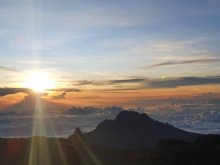
Marangu route 6 days Kilimanjaro Climbing
Product category:
Kilimanjaro Climbing Marangu Route
There are six established routes to climb Mount Kilimanjaro – Marangu, Machame, Lemosho, Shira, Rongai and Umbwe. The Marangu, Machame, and Umbwe routes all approach from the south of the mountain. The Lemosho and Shira routes approach from the west. The Rongai route approaches from the north near Kenya. All routes except Marangu and Rongai descend via Mweka.
Climbing Mount Kilimanjaro via The 6 days Marangu Route
Marangu Route, commonly known as the Coca Cola route is more popular because it can be done in fewer days and has permanent sleep huts at the campsites.
Summit night from Kibo Hut is steep and passes Gilman’s Point to Uhuru Peak. It is a shorter route with a steeper incline and less time for acclimatization it tends to have a lower summit success rate. This is the only route where the ascent and descent route is shared, thus creating more traffic.
Day 0: Pre-trek Briefing
If you have opted for the optional airport transfers, we will pick you up from Kilimanjaro Airport or Arusha airport and transfer you to your hotel in Moshi.
Pre-trek briefing at your Moshi hotel. You should be planning to arrive at least one day before the start of the trek. Today we will spend time having a pre-trek briefing. We will also review your equipment and rent any equipment which is needed.
Day 1: Hotel to Mandara Hut
After breakfast and briefing, drive to the Kilimanjaro National Park Gate (about 1 hour), register and commence the climb. Walk through the rainforest to the Mandara encampment. A side trip to Maundi Crater is a good way to see the surroundings including Northern Tanzania and Kenya. In the rainforest, look for towering Eucalyptus trees, bird life, and Colobus monkeys.
Elevation: 1860m/6100ft to 2700m/8875ft
Distance: 8km/5mi
Hiking Time: 3-4 hours
Habitat: Montane Forest
Meals: Lunch and Dinner
Day 2: Mandara Hut to Horombo Hut
You leave the glades of the rain-forest and follow an ascending path on the open moorlands to the Horombo encampment. Views of Mawenzi and the summit of Kibo are amazing. Look for giant lobelias and grounsels. You may begin to feel the affects of the altitude.
Elevation: 2700m/8875ft to 3700m/12,200ft
Distance: 12km/7.5mi
Hiking Time: 5-6 hours
Habitat: Heathland
Meals: Breakfast, Lunch and Dinner
Day 3: Rest Day at Horombo Hut
Rest day at Horombo Hut with optional hike by Mawenzi Peak.
Elevation: 3700m/12,200ft
Distance: 0km/0mi
Hiking Time: 0 hours
Habitat: Heathland
Meals: Breakfast, Lunch and Dinner
Day 4: Horombo Hut to Kibo Hut
Ascending, we now pass the last watering point, walking onto the saddle of Kilimanjaro between the peaks of Kibo and Mawenzi. Vegetation begins with upper heathland but then disappears into “moonscape”. Dinner, rest, and prepare for summit climb.
Elevation: 3700m/12,200ft to 4700m/15,500ft
Distance: 9km/5.5mi
Hiking Time: 5-6 hours
Habitat: Alpine Desert
Meals: Breakfast, Lunch and Dinner
Day 5: Kibo Hut to Summit to Horombo Hut
Very early in the morning (midnight to 2 am), commence the climb to the summit on steep and heavy scree or snow up to Gilman’s point located on the crater rim. Continuing, we now ascend to Uhuru Peak, which is the highest point in Africa. There are unbelievable views at every turn. Have your picture taken at the summit to show your friends and family. From here we descend, stopping for lunch and a rest at Kibo before continuing on to the Horombo encampment.
Elevation: 4700m/15,500ft to 5895m/19,340ft
Down to 3700m/12,200ft
Distance: 6km/4mi up / 15km/9mi down
Hiking Time: 6-8 hours up / 15km/9mi down
Habitat: Alpine Desert
Meals: Breakfast, Lunch and Dinner
Day 6: Horombo Hut to Moshi
After breakfast, a steady descent takes us down through moorland to the Mandara Hut. Continue descending through lush forest path to the National Park gate at Marangu. At lower elevations, it can be wet and muddy. Gaiters and trekking poles will help. Shorts and t-shirts will probably be plenty to wear (keep rain gear and warmer clothing handy).
A vehicle will be waiting for you at Marangu gate to drive you back to your hotel in Moshi (about 1 hour).
Elevation: 3700m/12,200ft to 1700m/5500ft
Distance: 20km/12.5mi
Hiking Time: 4-5 hours
Habitat: Forest
Meals: Breakfast
Inclusions
All transfers to the mountain and back to your Moshi hotel
Professional, experienced, mountain guides
Guides, Porters, Cook salaries and park fees
Sleeping Mattress
Emergency Oxygen Cylinder
All meals while on the Mountain
Large portions of fresh, healthy, nutritious food
Clean, purified drinking water
Conservation fees (part of park fees)
Camping or Hut fees (part of park fees)
Rescue fees (part of park fees)
VAT (18% charged by the Government)
Kilimanjaro summit certificate
Exclusions
Tanzania Visa
International and domestic flights
Hotel (available as an optional addon)
Transfers (available as an optional addon)
Personal trekking equipment such as sleepings bags, hiking boots, clothes, etc (available for renting)
Tips and gratuities
Travel insurance
Personal Expenses (e.g. laundry, telephone, beverages, etc.)
Meals not listed in the itinerary
Liquors, beers and bottled beverages
Surcharge for online payment of advance and balance (5% on each payment)

Marangu route 5 days Kilimanjaro Climbing
Product category:
Kilimanjaro Climbing Marangu Route
There are six established routes to climb Mount Kilimanjaro – Marangu, Machame, Lemosho, Shira, Rongai and Umbwe. The Marangu, Machame, and Umbwe routes all approach from the south of the mountain. The Lemosho and Shira routes approach from the west. The Rongai route approaches from the north near Kenya. All routes except Marangu and Rongai descend via Mweka.
Climbing Mount Kilimanjaro via The Marangu Route
Marangu Route, commonly known as the Coca Cola route is more popular because it can be done in fewer days and has permanent sleep huts at the campsites.
Summit night from Kibo Hut is steep and passes Gilman’s Point to Uhuru Peak. It is a shorter route with a steeper incline and less time for acclimatization it tends to have a lower summit success rate. This is the only route where the ascent and descent route is shared, thus creating more traffic.
Day 0: Pre-trek Briefing
If you have opted for the optional airport transfers, we will pick you up from Kilimanjaro Airport or Arusha airport and transfer you to your hotel in Moshi.
Pre-trek briefing at your Moshi hotel. You should be planning to arrive atleast one day before the start of the trek. Today we will spend in having a pre-trek briefing. We will also review your equipment and rent any equipment which is needed.
Day 1: Hotel to Mandara Hut
After breakfast and briefing, drive to the Kilimanjaro National Park Gate (about 1 hour), register and commence the climb. Walk through the rainforest to the Mandara encampment. A side trip to Maundi Crater is a good way to see the surroundings including Northern Tanzania and Kenya. In the rainforest, look for towering Eucalyptus trees, bird life, and Colobus monkeys.
Elevation: 1860m/6100ft to 2700m/8875ft
Distance: 8km/5mi
Hiking Time: 3-4 hours
Habitat: Montane Forest
Meals: Lunch and Dinner
Day 2: Mandara Hut to Horombo Hut
You leave the glades of the rain-forest and follow an ascending path on the open moorlands to the Horombo encampment. Views of Mawenzi and the summit of Kibo are amazing. Look for giant lobelias and grounsels. You may begin to feel the affects of the altitude.
Elevation: 2700m/8875ft to 3700m/12,200ft
Distance: 12km/7.5mi
Hiking Time: 5-6 hours
Habitat: Heathland
Meals: Breakfast, Lunch and Dinner
Day 3: Horombo Hut to Kibo Hut
Ascending, we now pass the last watering point, walking onto the saddle of Kilimanjaro between the peaks of Kibo and Mawenzi. Vegetation begins with upper heathland but then disappears into “moonscape”. Dinner, rest, and prepare for summit climb.
Elevation: 3700m/12,200ft to 4700m/15,500ft
Distance: 9km/5.5mi
Hiking Time: 5-6 hours
Habitat: Alpine Desert
Meals: Breakfast, Lunch and Dinner
Day 4: Kibo Hut to Summit to Horombo Hut
Very early in the morning (midnight to 2 am), commence the climb to the summit on steep and heavy scree or snow up to Gilman’s point located on the crater rim. Continuing, we now ascend to Uhuru Peak, which is the highest point in Africa. There are unbelievable views at every turn. Have your picture taken at the summit to show your friends and family. From here we descend, stopping for lunch and a rest at Kibo before continuing on to the Horombo encampment.
Elevation: 4700m/15,500ft to 5895m/19,340ft
Down to 3700m/12,200ft
Distance: 6km/4mi up / 15km/9mi down
Hiking Time: 6-8 hours up / 6-8 hours down
Habitat: Alpine Desert
Meals: Breakfast, Lunch and Dinner
Day 5: Horombo Hut to Moshi
After breakfast, a steady descent takes us down through moorland to the Mandara Hut. Continue descending through lush forest path to the National Park gate at Marangu. At lower elevations, it can be wet and muddy. Gaiters and trekking poles will help. Shorts and t-shirts will probably be plenty to wear (keep rain gear and warmer clothing handy).
A vehicle will be waiting for you at Marangu gate to drive you back to your hotel in Moshi (about 1 hour).
Elevation: 3700m/12,200ft to 1700m/5500ft
Distance: 20km/12.5mi
Hiking Time: 4-5 hours
Habitat: Forest
Meals: Breakfast
Inclusions
All transfers to the mountain and back to your Moshi hotel
Professional, experienced, mountain guides
Guides, Porters, Cook salaries and park fees
Sleeping Mattress
Emergency Oxygen Cylinder
All meals while on the Mountain
Large portions of fresh, healthy, nutritious food
Clean, purified drinking water
Conservation fees (part of park fees)
Camping or Hut fees (part of park fees)
Rescue fees (part of park fees)
VAT (18% charged by the Government)
Kilimanjaro summit certificate
Exclusions
Tanzania Visa
International and domestic flights
Hotel (available as an optional addon)
Transfers (available as an optional addon)
Personal trekking equipment such as sleepings bags, hiking boots, clothes, etc (available for renting)
Tips and gratuities
Travel insurance
Personal Expenses (e.g. laundry, telephone, beverages, etc.)
Meals not listed in the itinerary
Liquors, beers and bottled beverages
Surcharge for online payment of advance and balance (5% on each payment)
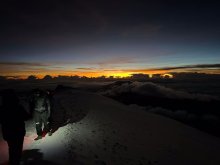
FAQ:
What is Kilimanjaro?
Kilimanjaro is the tallest mountain in Africa, located in Tanzania. It is a dormant volcano with three volcanic cones: Kibo, Mawenzi, and Shira. Climbing Kilimanjaro is a popular adventure activity attracting thousands of trekkers every year.
How tall is Kilimanjaro?
The highest peak of Kilimanjaro, Uhuru Peak, stands at an elevation of 5,895 meters (19,341 feet) above sea level, making it the highest point in Africa.
How long does it take to climb Kilimanjaro?
The duration of a Kilimanjaro climb can vary depending on the chosen route and itinerary. Most trekkers opt for 5 to 9-day routes, allowing for proper acclimatization and maximizing the chances of reaching the summit.
What are the main routes to climb Kilimanjaro?
There are several routes to climb Kilimanjaro, each offering unique landscapes and experiences. Some popular routes include the Machame Route, Marangu Route, Lemosho Route, Rongai Route, and the Northern Circuit.
Do I need previous climbing experience to climb Kilimanjaro?
While prior climbing experience is not mandatory, it is recommended to have a good level of fitness and endurance for the Kilimanjaro trek. The trails can be challenging, and altitude sickness is a potential risk, so being physically prepared is essential.
What is the best time to climb Kilimanjaro?
The best time to climb Kilimanjaro is during the dry seasons, which are typically from late June to October and from December to mid-March. These months offer the best weather conditions and higher chances of clear skies for summiting.
Do I need a guide to climb Kilimanjaro?
Yes, it is mandatory to climb Kilimanjaro with a certified guide. Guides are experienced in leading treks on the mountain, ensuring safety, providing support, and assisting with altitude acclimatization.
What should I pack for a Kilimanjaro climb?
Essential items to pack for a Kilimanjaro climb include appropriate clothing for varying temperatures, sturdy hiking boots, a sleeping bag, medications for altitude sickness, water purification tablets, and high-energy snacks.
Is altitude sickness common on Kilimanjaro?
Altitude sickness, also known as acute mountain sickness (AMS), is a common concern for climbers ascending Kilimanjaro. Symptoms may include headache, nausea, dizziness, and fatigue. Adequate acclimatization and a gradual ascent can help minimize the risk of altitude sickness.
Is it possible to climb Kilimanjaro solo?
While it is technically possible to climb Kilimanjaro solo, it is not recommended due to safety concerns. Having a certified guide and a support team is crucial for navigation, safety, and assistance in case of emergencies.
What is a Tanzania safari?
A Tanzania safari is a wildlife adventure tour that takes visitors into the natural habitats of Tanzania's national parks and game reserves to observe and photograph wild animals in their natural environment.
What are the main safari destinations in Tanzania?
Tanzania is home to several iconic safari destinations, including Serengeti National Park, Ngorongoro Crater, Tarangire National Park, Lake Manyara National Park, and Selous Game Reserve, among others.
What wildlife can I see on a Tanzania safari?
Tanzania is renowned for its diverse wildlife, including the Big Five (lion, elephant, buffalo, leopard, rhinoceros), as well as cheetahs, giraffes, zebras, wildebeests, hippos, crocodiles, and a variety of bird species.
When is the best time to go on a Tanzania safari?
The best time for a Tanzania safari depends on the specific destinations and wildlife experiences you seek. Generally, the dry season (from June to October) offers optimal wildlife viewing as animals congregate around water sources. However, the green season (from November to May) offers lush landscapes, fewer crowds, and the opportunity to witness the Great Migration in the Serengeti.
What types of safaris are available in Tanzania?
Tanzania offers a range of safari experiences, including game drives in 4x4 vehicles, walking safaris, hot air balloon safaris, birdwatching tours, cultural tours to Maasai villages, and luxury tented camps or lodges.
Do I need a visa to visit Tanzania for a safari?
Visitors to Tanzania typically require a tourist visa, which can be obtained upon arrival at major entry points or in advance from Tanzanian embassies or consulates in their home countries.
What should I pack for a Tanzania safari?
Essential items to pack for a Tanzania safari include lightweight and breathable clothing in neutral colors, a wide-brimmed hat, sunglasses, sunscreen, insect repellent, binoculars, a camera with extra batteries and memory cards, and any necessary medications.
Is it safe to go on a Tanzania safari?
Tanzania is generally considered safe for tourists, including safari-goers. However, it's essential to follow safety guidelines provided by your tour operator or guide and to be cautious of wildlife encounters.
How do I choose a safari operator in Tanzania?
When selecting a safari operator in Tanzania, consider factors such as their reputation, experience, certifications, customer reviews, and the quality of their guides, vehicles, and accommodations.
What is the typical duration of a Tanzania safari?
The duration of a Tanzania safari can vary depending on your preferences and itinerary. Safaris can range from a few days to several weeks, with most visitors opting for 3 to 7-day safari packages.
What is a Kenya safari?
A Kenya safari is a wildlife adventure tour that takes visitors into the natural habitats of Kenya's national parks, game reserves, and conservancies to observe and photograph wild animals in their natural environment.
What are the main safari destinations in Kenya?
Kenya is renowned for its diverse safari destinations, including Maasai Mara National Reserve, Amboseli National Park, Tsavo National Parks (East and West), Samburu National Reserve, Lake Nakuru National Park, and Aberdare National Park, among others.
What wildlife can I see on a Kenya safari?
Kenya is home to a wide variety of wildlife, including the Big Five (lion, elephant, buffalo, leopard, rhinoceros), as well as cheetahs, giraffes, zebras, wildebeests, hippos, crocodiles, and numerous bird species.
When is the best time to go on a Kenya safari?
The best time for a Kenya safari depends on the specific destinations and wildlife experiences you seek. Generally, the dry season (from June to October) offers optimal wildlife viewing, particularly during the Great Wildebeest Migration in the Maasai Mara. However, Kenya's diverse ecosystems make it a year-round destination for safaris.
What types of safaris are available in Kenya?
Kenya offers a range of safari experiences, including game drives in 4x4 vehicles, walking safaris, hot air balloon safaris, birdwatching tours, cultural visits to Maasai villages, and luxury tented camps or lodges.
Do I need a visa to visit Kenya for a safari?
Visitors to Kenya typically require a tourist visa, which can be obtained upon arrival at major entry points or in advance from Kenyan embassies or consulates in their home countries.
What should I pack for a Kenya safari?
Essential items to pack for a Kenya safari include lightweight and breathable clothing in neutral colors, a wide-brimmed hat, sunglasses, sunscreen, insect repellent, binoculars, a camera with extra batteries and memory cards, and any necessary medications.
Is it safe to go on a Kenya safari?
Kenya is generally considered safe for tourists, including safari-goers. However, it's essential to follow safety guidelines provided by your tour operator or guide and to be cautious of wildlife encounters.
How do I choose a safari operator in Kenya?
When selecting a safari operator in Kenya, consider factors such as their reputation, experience, certifications, customer reviews, and the quality of their guides, vehicles, and accommodations.
What is the typical duration of a Kenya safari?
The duration of a Kenya safari can vary depending on your preferences and itinerary. Safaris can range from a few days to several weeks, with most visitors opting for 3 to 7-day safari packages.
Contact:
Login or register to see the contact information!
Address information
Moshi, Tanzania
Boma Rd
25101 Moshi
Tanzania Similar companies
Other
Other
Financial Services
Latest startups


